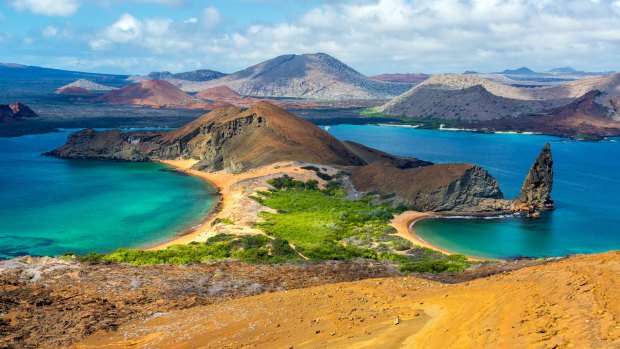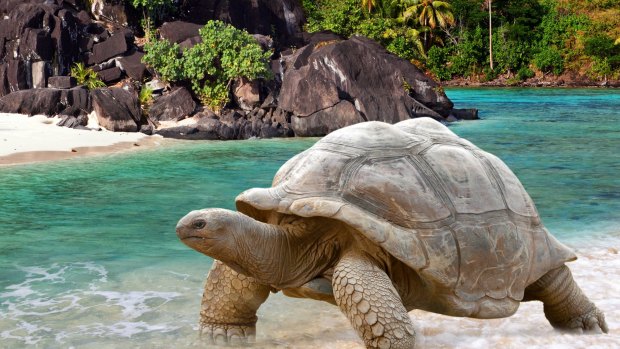This was published 6 years ago
The Galapagos cruise: Come for the wildlife, stay for the thrilling landscape

A view from Bartolome Island.
The coiling monotone terrain is like nothing I've ever seen. It's as if hundreds of ropes, all plaited together, have twisted and turned on top of themselves, then petrified forming the alien landscape before me.
We all step off the Zodiac without saying a word, our eyes pirouetting left, right and centre, and then for what feels like a long time we stride silently and slowly, staring at the beautiful tangled mess beneath us. Eventually Kathy, one of the three naturalists guiding the expedition, breaks our trance with the story of the we are walking on – considered one of the finest examples in the world.
Most people who travel to the Galapagos Islands come for the wildlife – and rightly so. There is nowhere else in the world you can walk among blue-footed, red-footed and nasca boobies, Galapagos albatrosses, land and marine iguanas, Galapagos sea lions, Galapagos giant tortoises … the list goes on. The geology of the islands, however, should not be overlooked.

A Galapagos giant tortoise.
I'm cruising around the Galapagos with Aurora Expeditions and the islands we are visiting were formed between 3 to 5 million years ago – so in geological time they are relatively young. Technically, though, the Galapagos Islands were formed about 8 million years ago, it's just that tourists don't visit those older islands as they are now submerged under the sea.
Today the Galapagos archipelago is home to 13 large islands, six small islands, and many islets and rocky crests. Cruising is by far the best way to experience the diversity and vastness, both in wildlife and geological terms. No island is the same (the terrain and wildlife on each island can differ greatly between coastal and inland areas), so you could theoretically spend weeks, years even, floating around and still be discovering. Over nine days we'll be visiting 10 islands, focusing on spotting as many of the endemic fauna as we can, but also participating in a range of other activities, including walking on ancient lava flow, learning about sugar cane production, and exploring some of the buzzy island towns.
We board Isabela II, our rather swish floating home away from home for the next nine days, from the city of Puerto Ayora on Santa Cruz Island a few days before our lava flow walk, and are immediately made to feel welcome. Hotel manager Gerd shows us around the elegant vessel and introduces us to the 27 crew. Over the next few days I learn that the three naturalists accompanying us – Kathy, Jose and Sabina – are super stars packed with information and passion for the islands.
Each day we head out on several land-based and water activities (with a long lunch and siesta in the middle of the day) and all three can – truly – talk non-stop about boobies, volcanoes, sea lions, iguanas, soil, weather, plant life, and anything that relates even remotely to whatever topic we are covering.
One of our first excursions is to Santa Fe Island, where we watch playful sea lions gambol and colourful land iguanas bask in the warm sun. "Sea lions and seals are very different," Jose says. "Sea lions have ears and they can walk, run and climb, while seals move more like caterpillars on the land."
On North Seymour Island I learn that Kathy can talk and walk non-stop as we spot blue-footed boobies, sea lions, land iguanas and sea iguanas.
On Santa Cruz Island we discover a couple of pink-feather flamingos strutting about in the brackish lagoon behind the beach. Here, Sabina tells us that flamingos are one of only three bird species in the world that produce milk and I add this detail to my mental list of weird and wonderful facts that I'm sure will be useful for pub trivia one day.
Although wildlife sightings are the main attraction, the geology of the islands is an underlying theme, woven into the evolution of the island natives – whether plant or animal.
It's a big focus on day four, with the Santiago Island lava walk scheduled for the afternoon and a visit to Bartolome Island planned for the morning.
Bartolome Island is one the younger islands in the archipelago – an extinct volcano that is home to terrain in various stages of erosion. It's best known for Pinnacle Rock, an enormous spearheaded column that is a relic of an eroded tuff cone. Although it's an astonishing sight at eye level, hiking the 600-metre uphill track to admire it from above comes highly recommended.
I take my time climbing – not because I'm struggling (that's what I tell everyone anyway) – but because the landscape is like nothing I've ever seen; it's as if hundreds of mini rockets have been lined up ready for launch next to rivers of lava frozen in time.
Eventually I reach the top and again I linger. I know the team is ready for us on the beach with the glass-bottomed boat, kayaks and snorkelling gear, but the patchwork of dusty browns and mellow yellows painted on a turquoise blue canvas below has me mesmerised.
A lunchtime Mexican-themed feast on the deck replenishes energy levels, and when it's time to go to Santiago Island, aches and pains are but a distant memory.
The three Zodiacs pull into Sullivan Bay and remarkably I hear very little – no chitchat, no questions, just the soft lapping of water against the inflated boat.
Everyone disembarks silently, inspecting where best to place feet on the uneven ground. It's eerily quiet and our only non-human company consists of a few painted locusts and lava lizards. Even plant life is virtually non-existent; we see one lava cactus and the sporadic scattering of carpetweed.
Kathy, Jose and Sabina eventually start to talk, explaining how the lava began to form after a volcano eruption in 1897. Admiring the solidified lava – swirling braid-like formations that coil around like twisting veins – it's easy to imagine the once-molten lava gushing down and sending columns of steam into the air.
We don't have any more near-silent experiences. Darwin's finches whistle to each other; sea lions snort and scuffle; Galapagos albatrosses click and clatter their beaks on Espanola Island. Back on Isabella II we're all just as loud, reliving our daily experiences while soaking in bubbles in the spa or ordering bubbles at the bar.
Towards the end of the week we visit Floreana Island, a 3-million-year old land mass that made Darwin's hit list in 1832. Seabirds, sea lions and marine iguanas lounge around, but I'm more interested in the green-tinged beach sand, which appears khaki green because it's comprised of tiny olivine crystals that are volcanic remnants.
Two days later on San Cristobal Island, an old island made up of three or four extinct volcanoes, we encounter another olivine beach, but this time the wildlife wins out. Pitt Point is the only site in the Galapagos where you can see all three species of boobies (blue-footed, red-footed and nasca boobies) and two species of frigatebirds (great and magnificent) nesting close to each other … and predictably it's a mad racket.
Hundreds of birds screech as they flutter and parade around; the naturalists have to raise their voices to compete with the unrelenting squawking; one guest after another runs out of space on their camera.
It's a fitting end to the trip of a lifetime – exciting, startling, remarkable – just like the islands themselves.
TRIP NOTES
MORE
CRUISE
The nine-day Galapagos Odyssey expedition is scheduled for September 18 to 26, 2017, and includes return flights from Quito to Baltra, eight nights' accommodation, all meals on the ship, and all guiding services and shore excursions. See auroraexpeditions.com.au
FLY
LATAM flies from Sydney to Santiago, with connections to Quito. See latam.com
STAY
Designed for Galapagos exploration, Aurora Expeditions' Isabela II is an elegant expedition ship fitted out with Zodiacs, sea kayaks and a glass-bottom boat. The 20 cabins offer twin or double bedding, all with outside windows. Guests spend most of their time onboard taking in the vistas from the outer decks, eating delicious meals, and enjoying drinks in the communal lounge bar.
Tatyana Leonov travelled as a guest of Aurora Expeditions.
FIVE MORE OUT-OF-THIS WORLD VOLCANO EXPERIENCES
KILAUEA, HAWAII
Hawaii is a hotpot of volcano experiences (excuse the pun) and Kilauea is one of the most visited active volcanoes in the world, erupting more than 60 times since Europeans started counting. The last and current eruption was in 1983 … and the lava is still spattering!
MOUNT RUAPEHU, NEW ZEALAND
New Zealand's most active volcano has several peaks and is home to the North Island's only glaciers. Hiking the 19-kilometre Tongariro Alpine Crossing is a great way to get a feel for the lunar-like landscape; otherwise mountain biking or kayaking while taking in the vistas comes highly recommended.
KAWAH IJEN, INDONESIA
There are more active volcanoes in Indonesia than in any other country, but one that doesn't get much international attention – and it should! – is Kawah Ijen in Java. Some nights electric-blue "fire" can be seen gushing down the mountain; it's not lava, but sulfuric gases that give that eerie bright blue appearance when next to lava.
MOUNT MAELIFELL, ICELAND
Prepare to be gobsmacked: Mount Maelifell is a volcanic cone that was created by one of the many eruptions that occurred under the ice of the Myrdalsjokull glacier near the end of the Ice Age. Today this green-moss covered peak, surrounded by a sprawling black desert-like expanse of glacial sand, is as dramatic as they come. You can hike around it and up it, or book a jeep tour to cover more ground.
MOUNT FUJI, JAPAN
Japan's national symbol is scaled by about 300,000 tourists annually, who hike to the summit during the short climbing season (July to August). City slickers can appreciate the view on a clear day from one of Tokyo's many observation decks.
Sign up for the Traveller Deals newsletter
Get exclusive travel deals delivered straight to your inbox. Sign up now.